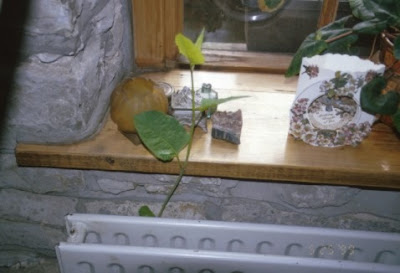Day of the triffids?
(Japanese Knotweed)
(Japanese Knotweed)
At the councils Great Get Together, one concerned local resident came up to me on the PCEG stall and asked what was being done about the Japanese Knotweed, which was to be found on the western end of the Common, by St Johns Terrace. I of course stared at him blankly and asked if he wanted to join so he could bring the matter up at the next meeting (Sunday 8th July, St Mark's and St Margaret's Church Hall, 3pm), at which he baulked at the £4 cost of annual membership, so I guess he wasn't really that concerned about it after all.
 It looks like bamboo, but isn't related. It blocks out completing native species, and forms a large 'monoculture stand'. Its organic waste forms a deep layer and prevents native species seeds from germinating.
It looks like bamboo, but isn't related. It blocks out completing native species, and forms a large 'monoculture stand'. Its organic waste forms a deep layer and prevents native species seeds from germinating. It did however ring a few bells as I remember reading about some problems that residents of Chelsworth Drive and Tuam Road were having with said weed growing on waste land behind their homes.
I also then saw it mentioned in the management plan for Plumstead Common as something that threatened the biodiversity of the Common and that effort should be made to eliminate it. So in the interests of I science I decided to investigate a bit more. What I found out was rather scary. The plant is an absolute menace and is running amok in the UK as it has no natural controls such as insect, parasites etc. to keep it in check. It is deemed so hazardous and threatening to the environment that it is illegal to spread it under the Wildlife and Countryside Act 1981. You can find out more about Japanese Knotweed here.
I have to say if I lived in St Johns Terrace I would be rather concerned as 'The rhizome (posh word for roots I think) system may extend from a parent plant up to 7 meters laterally and to a depth of 3 metres'. That means that the roots for the problem plant can go over 21 feet sideways. So the weed on land looked after by the council can come under the road and footpath and up into your front garden or even your front room, damaging your property in the process. It is already breaking up the footpath on the side by the Common.
I will certainly be asking the Council what they intend to do about it when I go to the Council's Parks Friends Buffet on the 13th July.
Labels: Japanese Knotweed, Plumstead Common








4 Comments:
That evil stuff keeps coming under my back fence, travelling 4 feet under a path and appearing in my raised vegetable beds. I'm saving up for a flamethrower as I write.
Hmm....we have a problem with it in Erith and Franks Park.
VERY interesting link too; "It is only one of two terrestrial plants dealt with by the current version of the UK Wildlife and Countryside Act..", if its only one of two TERRESTRIAL plants what about all the EXTRATERRESTRIAL one's Hur???!
;-)
I have some creeping into my garden from the alley and a couple of years ago attacked it (even though it's Council Property)then dug up the ground THEN salted it with neat Industrial strength weedkiller AND watered it with weedkiller regularly.
Finally got it.
Abit of a "scorched earth policy" as it ment my bit of alley is completly weed, grass and animal free but I GOT IT!!
AHAHAHA!
Then a new lot appeared further down the alley a year or so after but as thats not near me I conseded defeat!
RHIZOMES are subterreanean root systems. They are not like a regular, linear arborescent (tree) root system which has a root centre. If you were to attach that single centre, the tree would die. But rhizomes are lateral, they reach our in many directions at once, and have multiple root centres, which you can't see at work, and can insidiously overwhelm other plants' roots. And, from what this blog reports, frighteningly even attack the foundations of houses. The thing that's amazing is that it simply means that nature really can fight back and take over. But of course very very damaging to our built environment. Really interesting blog entry!
My tiny telly-based knowledge syas that neglecting it is a bad move with this plant-- it gets really hard to budge after a while as happens in rural areas.
Post a Comment
<< Home